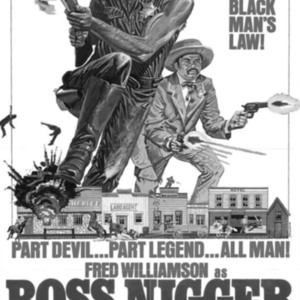Boss Nigger (1975)
Dublin Core
Title
Boss Nigger (1975)
Description
Despite taking place in a different setting, Boss Nigger continues to reproduce the stereotype of black masculinity seen throughout the Blaxploitation genre. On the promotional material for Boss Nigger, the star, Boss (Fred Williamson), runs towards the viewer, shooting a gun, and crushing buildings in his path. He is portrayed as extremely large and strong in this picture, especially when compared to his sidekick, Amos (D’Urville Martin), who stands smaller behind him. Blaxploitation films often produce characters with hyper masculinity and superhuman strength, reflected in the image used to promote the film.
Jeffery A. Brown argues in his book, Black Superheroes, Milestone, Comics and Their Fans, that Blaxploitation grew out “the immense black audience looking for heroic characters” (152). Many black superhuman characters emerged in the Blaxploitation era in order to satisfy this desire. For example, in Sweet Sweetback Badassss Song the main character has superhuman qualities in which he able to outrun any man and defeat a pack of ravaged dogs. This form of action hero can also been seen in the film Shaft (1971), in which the audience watches a suave black detective defeat mafia and mob members.
In Boss Nigger, Boss is similarly portrayed as a black superhero. On the poster the words “Part Devil…Part Legend…All Man!” appear at his feet, suggesting that he has more power than an average man. Boss seems to have full control over his surroundings, defeating any foe in his path and seeming almost bulletproof during duels. His heightened masculinity and superhuman status is additionally echoed by the fact that Williams was a sports star, a profession that is highly connected to the masculine identity of the United States.
The frontier town setting also contributes to this idea of a superhero and hyper masculine ideals. The emerging urban setting is regarded as a place of chaos in which only the baddest and bravest can survive. The boss’ expert negotiation of the land and his ability to gain power in a white dominated area furthers the notion that he is invincible to the audience members. Furthermore, the idea of the cowboy has been ingrained in America’s mind as the epitome of manliness. In his book, The Cowboy Hero, William Savage explains that the cowboy is an instantly recognizable symbol of America. Through the Boss’ western setting in Boss Nigger, the Boss already has recognizable status and prestige due to the cowboy’s already distinguishable place in the minds of the audience. The setting of the Wild West also mimics the urban streets of Blaxploitation films. Even though Boss is a cowboy, his actions and demeanor allow for the audience to draw a connection between him and the hard, hypermasculinized heroes of the streets seen in similar movies of the time.
Brown, Jeffrey, Black Superheroes, Milestone Comics, and Their Fans University, Press of Mississippi, USA 2001.
Guerrero, Ed, Framing Blackness: the African American Image in Film, Temple University Press, 1993.
Savage, William, The Cowboy Hero: His Image in American History and Culture University of Oklahoma Press, USA 1979.
Van Peebles, Melvin Sweet Sweetback’s Badasssss Song, USA 1971
Williamson, Fred, Boss Nigger, USA 1975.
Jeffery A. Brown argues in his book, Black Superheroes, Milestone, Comics and Their Fans, that Blaxploitation grew out “the immense black audience looking for heroic characters” (152). Many black superhuman characters emerged in the Blaxploitation era in order to satisfy this desire. For example, in Sweet Sweetback Badassss Song the main character has superhuman qualities in which he able to outrun any man and defeat a pack of ravaged dogs. This form of action hero can also been seen in the film Shaft (1971), in which the audience watches a suave black detective defeat mafia and mob members.
In Boss Nigger, Boss is similarly portrayed as a black superhero. On the poster the words “Part Devil…Part Legend…All Man!” appear at his feet, suggesting that he has more power than an average man. Boss seems to have full control over his surroundings, defeating any foe in his path and seeming almost bulletproof during duels. His heightened masculinity and superhuman status is additionally echoed by the fact that Williams was a sports star, a profession that is highly connected to the masculine identity of the United States.
The frontier town setting also contributes to this idea of a superhero and hyper masculine ideals. The emerging urban setting is regarded as a place of chaos in which only the baddest and bravest can survive. The boss’ expert negotiation of the land and his ability to gain power in a white dominated area furthers the notion that he is invincible to the audience members. Furthermore, the idea of the cowboy has been ingrained in America’s mind as the epitome of manliness. In his book, The Cowboy Hero, William Savage explains that the cowboy is an instantly recognizable symbol of America. Through the Boss’ western setting in Boss Nigger, the Boss already has recognizable status and prestige due to the cowboy’s already distinguishable place in the minds of the audience. The setting of the Wild West also mimics the urban streets of Blaxploitation films. Even though Boss is a cowboy, his actions and demeanor allow for the audience to draw a connection between him and the hard, hypermasculinized heroes of the streets seen in similar movies of the time.
Brown, Jeffrey, Black Superheroes, Milestone Comics, and Their Fans University, Press of Mississippi, USA 2001.
Guerrero, Ed, Framing Blackness: the African American Image in Film, Temple University Press, 1993.
Savage, William, The Cowboy Hero: His Image in American History and Culture University of Oklahoma Press, USA 1979.
Van Peebles, Melvin Sweet Sweetback’s Badasssss Song, USA 1971
Williamson, Fred, Boss Nigger, USA 1975.
Citation
“Boss Nigger (1975),” WUSTL Digital Gateway Image Collections & Exhibitions, accessed July 8, 2024, http://omeka.wustl.edu/omeka/items/show/14333.

